 Analogue Model Railway Control
Analogue Model Railway Control
 Analogue Model Railway Control
Analogue Model Railway Control
> main > modelling > control > analogue control
Conventional DC or AC control
Using this kind of control has the advantage that it is to understand with basic knowledge of electricity and how electric circuits work. When you have a large layout the wiring can become very complicated and it is good to have good drawings of how the wiring is done. This is strongly recommended for all model railway wiring on any layout larger than a 4x8 ft board (1x2 metres). To control your trains you can either use the power pack supplied with the starter set or a more powerful power pack (transformer/controller). When using power packs I recommend a rating of at least 1 Amp, even for N-scale! European power packs offer single-knob control and an auxiliary 16V AC output for points and accessories. The manufacturers normally state for which system their equipment is made. Do NOT USE Märklin or other AC power packs, Japanese model trains all run on 0-12V DC.
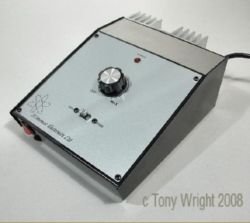 Helmsman standard controller (Photo: Helmsman Electronics)
Helmsman standard controller (Photo: Helmsman Electronics)When operaring more than one train simultaniously you will need to divide your layout in many sections or 'blocks', a switch wired to each block enables you to select the controller. When selecting a route for your train, you will also have to put the selector switches in the right position, to run your train on the same controller over the whole of the selected route. This needs extra wiring and making a drawing (schematic) of the wiring will become very useful for fault-finding. Do not neglect this! Even you will have a fault in your wiring. A good schematic will help you to rectify the fault quickly. I recommend a good book on model railway wiring, such as 'Easy Model Railroad Wiring', by Andy Sperandeo, published by Kalmbach Publishing.
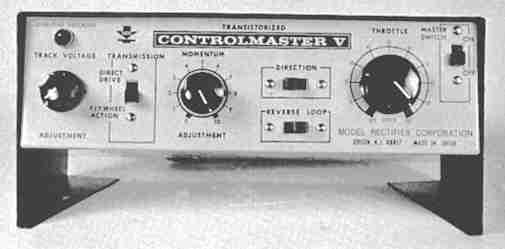 An
older analogue controller made by MRC, the controller
features adjustable momentum (inertia) and adjustable maximum track
voltage
(max. speed). Newer MRC controllers have hand-held controls, sound
effects
and more... (Photo: scan made from Electrical Handbook for Model Railroads Vol.1 by Paul Mellery, Carstens Publications, 1974)
An
older analogue controller made by MRC, the controller
features adjustable momentum (inertia) and adjustable maximum track
voltage
(max. speed). Newer MRC controllers have hand-held controls, sound
effects
and more... (Photo: scan made from Electrical Handbook for Model Railroads Vol.1 by Paul Mellery, Carstens Publications, 1974)
New developments in analogue controllers
At the moment most new model railway
control developments are in the
field of digital control (DCC!), analogue control is by no means
obsolete. A few German manufacturers have developed 'networked' analogue
controllers. In such a system, controllers are split into a held-held
control unit and an amplifier, that is mounted on the layout. The
amplifiers are connected with a control bus or other cabling. With such a
networked controller you can handover a train to a different controller
without any jerks, derailments etc.and eliminate the need for block
switches. Networked controllers are offered by Heisswolf and Uhlenbrock
('Daisy' system, can also be used as a DCC-control system). Another new
development are analogue output controllers that are controlled by a
smartphone or tablet. See this page for an overview.
More analogue controllers
This controller appeared on the market in 1975 and is still available! Development and original production was done in Belgium, but after the company ceased operation, production moved to the Netherlands. It's the TER 2103 controller. A pulse-width controller with adjustable acceleration and brake characteristics and an adjustable pulse for slow-speed shunting or high-speed mainline running. The controller has a luxurious finish, with aluminium faceplate, power output meters, wooden side panels and nextel top plate, as per 1975 vintage HiFi equipment!
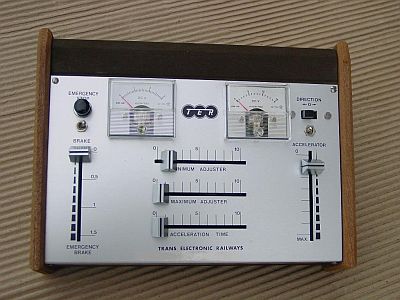 TER 2103 controller (photo: TER)
TER 2103 controller (photo: TER)
TER also offers an analogue block control system, which features signal and point control, smooth starting and stopping an precision braking on red signals. Also a non-recent development, but still available to modellers who do not want to put DCC decoders in their trains.
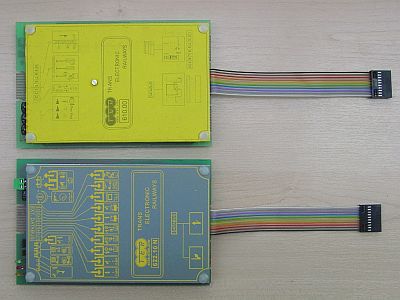 TER analogue block control cards (photo: TER)
TER analogue block control cards (photo: TER)
Recently I came across a website of a Swiss manufacturer named Elesdag that offers really great analogue controllers that are made to order. Capacity varies from 8 VA with limited voltage for 'Z' gauge to high capacity controllers suitable for battery powerd G-scale trains. The manufacurer also offer control panels for points and signals.
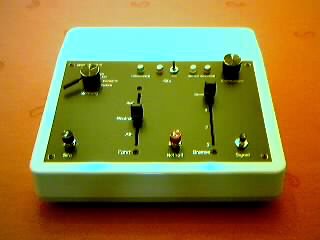 An example of an MBFS controller (photo Elesdag)
An example of an MBFS controller (photo Elesdag)
![]() Japanese
model railway
control
Japanese
model railway
control
In Japan most manufacturers (Kato, Tomix,
Endo, KTM) offer
transistorised
analogue controllers, which offer a much smoother control than the
conventional
transformer-controllers
offered by European manufacturers. Apart from smoother control, Kato and
Tomix
also have paid attention to the whole wiring system and both
manufacturers
have a convenient plug-in wiring system. However, the Kato and Tomix
wiring
systems are not compatible due to different plugs. More information is
available through the
links
below.
![]() An introduction
to
the Tomix control system
An introduction
to
the Tomix control system
A short description of the controllers and switches offered by Tomix.
 Cab-style
controllers. Many modellers always wanted to be a
train
driver, well with a cab-style controller you can
be
inthe driver's seat of your own model train. I made a survey of
what's
available from both Japanese and European manufacturers, both analogue
and
digital (DCC).
Cab-style
controllers. Many modellers always wanted to be a
train
driver, well with a cab-style controller you can
be
inthe driver's seat of your own model train. I made a survey of
what's
available from both Japanese and European manufacturers, both analogue
and
digital (DCC).
Direct-to-loco control
These systems use a constant voltage on the track for power (mostly 12V DC) and use infra-red or radio signals to control speed, direction, lights and other effects. A few manufacturers offer these systems. Normally the receivers inside the locos are quite bulky by todays standards, and are mainly aimed at the large-scale (O-scale and upwards) garden railway enthousiast.Rail Lynx (now out of business) offered an infrared system that fits into HO-scale locomotives. Across the rails is a constant 12V DC, or even a command control signal, which only powers the locos. The speed and direction command are transmitted directly to the locos, which should have IR detectors fitted. Repeater transmitters are available for use on hidden trackage. New is a large-scale loco decoder. Point motors, signals and other accessories are conventionally controlled, using normal electrical techniques.
 RCS
from Australia offers radio control. Several varieties exist, mainly
aimed
at large-scale modellers. However, there's a version which replaces
your stationary
controller. A small handset (about the size of a pack of cigarettes
[ooch,
I hate smoking:-)] is used by all RCS controllers.
RCS
from Australia offers radio control. Several varieties exist, mainly
aimed
at large-scale modellers. However, there's a version which replaces
your stationary
controller. A small handset (about the size of a pack of cigarettes
[ooch,
I hate smoking:-)] is used by all RCS controllers. Links to manufacturers of analogue controls.
Links to manufacturers of analogue controls.Gaugemaster offers a wide range of controllers, including controllers for Z-scale and large scales.
![]() Model Rectifier Corporation (MRC)
offer analogue and DCC controllers.
Model Rectifier Corporation (MRC)
offer analogue and DCC controllers.
Helmsman Electronics offers good controllers and a
control
panel building service. Other model railway electronic devices are also
on
offer. Helmsman has ended their operation, warranty claims are handeled by Peco. Sad to see them go. Good news!
Peco has taken over the Helmsman brand and will introduce new Helmsman
controllers. At first they aim at the larger modelling scales.
![]() Heisswolf
from Germany offers a very sophisticated analogue controller. It has a
memory
that stores the driving characteristics of your locos. German language
page.In 2022 this product range is continued by Tams.
Heisswolf
from Germany offers a very sophisticated analogue controller. It has a
memory
that stores the driving characteristics of your locos. German language
page.In 2022 this product range is continued by Tams.
Morley is a new name to me, they offer a range of 5 different types, with power outputs matching a certain scale. In the range there are models specifically made for 'Z', 'N', 'H0/00'and 0 scales. There's also a 4-output controller. All units come with 2 plug-in handheld controllers and have a built-in capacitor discharge unit plus an 1 Amp uncontrolled 12V DC output. Check the Morley website, they seem to offer good value-for-money.
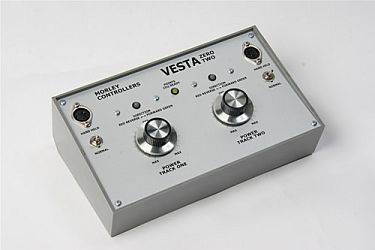 Morley 'Vesta 09' dedicated N-scale controller (photo: Morley Controllers)
Morley 'Vesta 09' dedicated N-scale controller (photo: Morley Controllers)
![]() Mondial Braemer
trades the
Lauer
range of model railway control devices, analogue controllers, power
supplies
and automation units.
Mondial Braemer
trades the
Lauer
range of model railway control devices, analogue controllers, power
supplies
and automation units.
.
 Cosmic
is a Japanese maufacturer of analogue controllers, they have a wide range,
including cab-style controllers and small controllers that could be
built-in into a mini-layout.
Cosmic
is a Japanese maufacturer of analogue controllers, they have a wide range,
including cab-style controllers and small controllers that could be
built-in into a mini-layout.< Back to the modelling page
< Back to the 'Take control' page
> Digital Command Control
 Modelling
Modelling Layouts
Layouts Modeller's
Corner
Modeller's
Corner  Train Simulators
Train Simulators  Various
Various